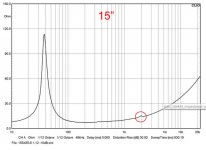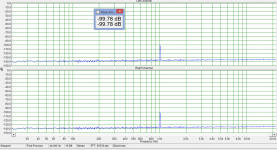Then some of us have been known to knock out a wall or significant bits of it to improve the listening area. A bit more work than tweaking a simulated amplifier design. But more of an improvement than that.
Next we could talk about ambient noise levels and actual signal to noise!
Ah, yes. Hard core. MY kinda guy
🙂 😎
Customizable blocks cut noise pollution 6X better - Futurity
Good point about s/n and dynamic range in real life..... Just using a CD with say thd at 96db down from zero.... Seems like a good dynamic range from that. But knock off 20 db because we arent going to listen at max output level. Now we have about 76 db range. We also have a typical home background noise level of 40db spl. Giving us barely 40db range. Sure we can hear into the noise but loose details. A clean, clear 40-50 db dynamic range max. wow. Impressive.
🙂
Somebody double-check these numbers. What do you get, Simon?
-Richard
Last edited:
Your estimation of CD dynamic range is wrong.
As was already mentioned by several of us some 20 pages ago.
Hans
Most all full range (20-20k) speakers are 3-ways......so a 2-way with subs is just that, no?
It’s all in the implementation.......when it’s blended correctly (dsp) you can’t tell the sub is there, well except for all that extra realism! 😛
The idea of a three way loudspeaker is that the fundamental of most instruments are all on a single driver, so they match better.
With a two way some instruments will change drivers just playing a scale. Harder to make that smooth.
Really has nothing to do with bass extension.
(Harman) Which also produces brilliant products like the CD5005 and some of the world's best loudspeakers under the JBL brand name.
Isn’t the CD5005 a Marantz product, and isn’t Marantz part of the Sound United group ?
Hans
Last edited:
Most all full range (20-20k) speakers are 3-ways......so a 2-way with subs is just that, no?
Here one of the advantages of horns. (Personal but definitive conclusions on my side).Thank you, that explains it. For most of us in more average size rooms, subwoofers are a real advantage and not just below 40Hz.
This way, it is possible to have a two way system, that cross around 700 Hz, with good enough basses and treebles. With the advantage that this crossing frequency is beyond the max sensitivity range of the human ears (1500 6000).
But, here, it requests a large diameter horn, that can be expensive and not WAF compliant. (36cm for both horn and speaker).
The limit is fixed by the usual frequency where the membrane of the bass speaker "break" and where the horn is cutting, keeping one octave of overlap for both (with 18 /24dB of acoustic slope).
An acceptable solution can be, indeed, to use a 26cm for bass and horn, to cut at 1500 Hz and to add a sub at 50-80 Hz.

Attachments
Could you please back up, from time to time, your statements with arguments and references ?Your estimation of CD dynamic range is wrong.
Because, as it stands, even wikipedia would not accept them.
I always found the 96 dB of CDs acceptable in matter of signal/noise ratio.
With careful listenings, not totally acceptable when definition of low levels instruments is in concern. Reason why the industry has moved to 24 bits.
44.1kHz/48kHz seems ok too, on a theoretical point of view. Many people found an improvement with 96 kHz.
Last edited:
A 16 bit digital source will come close to 100 dB dynamic range reproducing a signal. Of course when the data produces a zero level signal the noise level can be below that. (16 x 6.02 +3.01)
As our hearing is modeled by critical bands and the noise is broadband we can often hear tones 20 dB below the noise floor.
In my house the noise is below 30 dBa, (I forget the actual measured number.) So I can hear from 10 dB to 110 dB until common sense would kick in. Note that with the sound rating of my house the neighbors would hear things around 60 dBa, loud enough to call the police. But below the noise pollution law limit.
Now allowing for 20 dB headroom that would put my slow weighted peak levels at 90 dB just a bit below the 94 - 96 I design for in public sports venues. (115 dB peaks.)
The kicker is that recordings do not match the available dynamic range perfectly, so higher bit size allows for better practical reproduction.
As our hearing is modeled by critical bands and the noise is broadband we can often hear tones 20 dB below the noise floor.
In my house the noise is below 30 dBa, (I forget the actual measured number.) So I can hear from 10 dB to 110 dB until common sense would kick in. Note that with the sound rating of my house the neighbors would hear things around 60 dBa, loud enough to call the police. But below the noise pollution law limit.
Now allowing for 20 dB headroom that would put my slow weighted peak levels at 90 dB just a bit below the 94 - 96 I design for in public sports venues. (115 dB peaks.)
The kicker is that recordings do not match the available dynamic range perfectly, so higher bit size allows for better practical reproduction.
Last edited:
So I can hear from 10 dB to 110 dB until common sense would kick in.
No you cannot, not at the same time. Your ears are acting as a dynamic range compressor.
We think the same thing. (You have a pretty silent room)In my house the noise is below 30 dBa, (I forget the actual measured number.) So I can hear from 10 dB to 110 dB until common sense would kick in.
I just want to add that our hearing system is able to discriminate the noise that comes from our speaker from the one of the ambiance of our listening room.
Not the same frequency range, not the same character.
Another question should be to agree on what is important or not. And here, the only way I found is to believe ... in what we can hear ;-)
No you cannot, not at the same time. Your ears are acting as a dynamic range compressor.
Detecting that a sound is there is different from "hearing" it. I have a few unlistenable 44/16 CD's where the quiet parts are totally unintelligible and add nothing to actually listening to/enjoying the music because they wanted DNR bragging rights.
We think the same thing. (You have a pretty silent room)
I just want to add that our hearing system is able to discriminate the noise that comes from our speaker from the one of the ambiance of our listening room.
Not the same frequency range, not the same character.
Another question should be to agree on what is important or not. And here, the only way I found is to believe ... in what we can hear ;-)
What you have two working ears! That allows even more discrimination than just signal to noise levels would indicate,
Always the same brutal assertions, never the slightest argument.No you cannot, not at the same time. Your ears are acting as a dynamic range compressor.
Our hearing is a system with limited total dynamics between the lowest discernible limit and the pain threshold, and a more limited capacity of analysis which adapts (like our vision) more or less quickly to the average levels to which we are exposed.
It's called the mask effect, and it's known to everyone. And, inside this limited dynamic window, we can focus more or less on the low levels, IE move a little this windows by our will.
Nothing so simple or obvious.
In fact, some kind of an expansor, IE the total opposite of what you said.
An other thing funny is the use of the word "compressor" as something that always reduce the dynamic. It is correlated with time. If you use slow attack time and long recovery time, you expand the dynamic of a signal. The attack of a note stay like it was, the sustain is reduced. We use this, often, to give more impact and life to kick drums, as an example.
Last edited:
A quiet house is a matter of detail. 10" of masonry wall checked for no pinholes or other penetrations and then floated from the masonry a bit of drywall with fiberglass. Also good for thermal isolation. Virtually all the noise comes through the double pane windows that also can have an additional outside panel. The windows are smaller than normal as it started out as heated by two wood fireplaces. Also no windows on the north side.
Front door built by me of white oak 2 full inches thick and required special hinges to take the weight. Full foam seals. Back door steel vandal resistant.
Heat is zoned hot water.
Roof was designed to take a slate roof so it is a bit beefier than most. Ceiling floats and has vermiculite and fiberglass. Vermiculite is out of fashion because some of it has been found to produce radon gas. Dried clay pellets are a good substitute. As my attic is ventilated, not an issue for me.
Front door built by me of white oak 2 full inches thick and required special hinges to take the weight. Full foam seals. Back door steel vandal resistant.
Heat is zoned hot water.
Roof was designed to take a slate roof so it is a bit beefier than most. Ceiling floats and has vermiculite and fiberglass. Vermiculite is out of fashion because some of it has been found to produce radon gas. Dried clay pellets are a good substitute. As my attic is ventilated, not an issue for me.
You should be used to him by now.but you did not even mention what exactly you wanted to prove with it.

I can imagine what your cat says to you...You can never have enough bass. 😀

Not to mention the stress taken off of mains' low end limit for less distortion.How do you get accurate bass in your room without subwoofers?
Perhaps you've had a misfortune of not auditioning a sound system with subwoofer/s properly set up.Just muddies up the sound.
Please be careful when you contradict / criticize RNMarsh because his bodyguard gets uneasy.Your estimation of CD dynamic range is wrong.
I wonder why some, here, try to contradict Mr. Marsh, whatever he says.
Please be careful when you contradict / criticize RNMarsh because his bodyguard gets uneasy.
I see. So how would he explain this?
Attachments
Re subsonic content.
Some FFTs (4M samples) from opera CD rips .
Remastering scissors are obvious.
George
Some FFTs (4M samples) from opera CD rips .
Remastering scissors are obvious.
George
Attachments
-
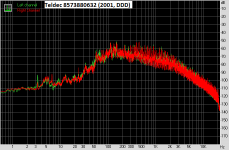 Teldec 8573880632 (2001, DDD).png21.7 KB · Views: 65
Teldec 8573880632 (2001, DDD).png21.7 KB · Views: 65 -
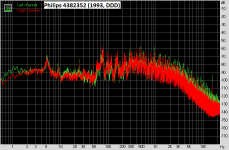 Philips 4382352 (1993, DDD).png23.6 KB · Views: 73
Philips 4382352 (1993, DDD).png23.6 KB · Views: 73 -
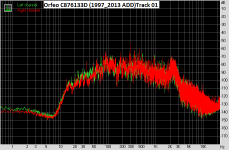 Orfeo C876133D (1997_2013 ADD)T 01.png23.3 KB · Views: 82
Orfeo C876133D (1997_2013 ADD)T 01.png23.3 KB · Views: 82 -
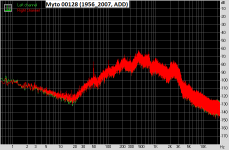 Myto 00128 (1956_2007, ADD.png20.8 KB · Views: 76
Myto 00128 (1956_2007, ADD.png20.8 KB · Views: 76 -
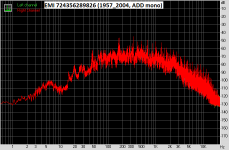 EMI 724356289826 (1957_2004, ADD mono).png18.8 KB · Views: 70
EMI 724356289826 (1957_2004, ADD mono).png18.8 KB · Views: 70 -
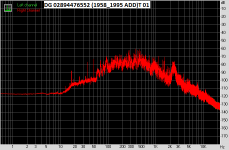 DG 02894476552 (1958_1995 ADD)T 01.png16.4 KB · Views: 166
DG 02894476552 (1958_1995 ADD)T 01.png16.4 KB · Views: 166 -
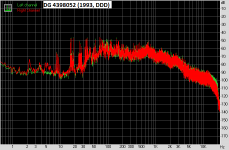 DG 4398052 (1993, DDD).png22.8 KB · Views: 165
DG 4398052 (1993, DDD).png22.8 KB · Views: 165 -
 Decca 470440-2 (1963_2002, ADD).png23.5 KB · Views: 194
Decca 470440-2 (1963_2002, ADD).png23.5 KB · Views: 194 -
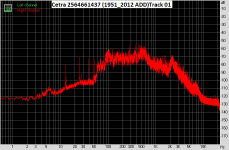 Cetra 2564661437 (1951_2012 ADD)T 01.png17.4 KB · Views: 199
Cetra 2564661437 (1951_2012 ADD)T 01.png17.4 KB · Views: 199 -
 Urania URN22144 (1950_2000, ADD mono).png22.1 KB · Views: 76
Urania URN22144 (1950_2000, ADD mono).png22.1 KB · Views: 76
A 16 bit digital source will come close to 100 dB dynamic range reproducing a signal. Of course when the data produces a zero level signal the noise level can be below that. (16 x 6.02 +3.01)
As our hearing is modeled by critical bands and the noise is broadband we can often hear tones 20 dB below the noise floor.
In my house the noise is below 30 dBa, (I forget the actual measured number.) So I can hear from 10 dB to 110 dB until common sense would kick in. Note that with the sound rating of my house the neighbors would hear things around 60 dBa, loud enough to call the police. But below the noise pollution law limit.
Now allowing for 20 dB headroom that would put my slow weighted peak levels at 90 dB just a bit below the 94 - 96 I design for in public sports venues. (115 dB peaks.)
The kicker is that recordings do not match the available dynamic range perfectly, so higher bit size allows for better practical reproduction.
Hmmm. I used the average as reported when i looked it up. I lived out in the country and did not have to do anything to the building but it too was lower than 40 spl background. But we ought to use average of most people's homes. IMO and thats what I did.
Few here listen at 110db spl. Though the M2 can do that with no pain to it.
Normal background levels for average homes and normal listening levels... that determined the range we (many) are listening.
Normal conversation is about 60db and a lawn mower about 90db. Many people here get upset at anything over 80db when they listen.
So just using what most people are actually exposed to in their home listening. NOT from max possible to anechoic chamber range.
So, the typical dynamic range in an average home and size and normal average listening levels leaves not much of a dynamic range as actually being listened to. 30-40db while listening.
Low level music and also details like reverb trail etal are lost quit easily. You really notice it when switching over to headphones.
THx-RNMarsh
Last edited:
- Status
- Not open for further replies.
- Home
- Member Areas
- The Lounge
- John Curl's Blowtorch preamplifier part III
